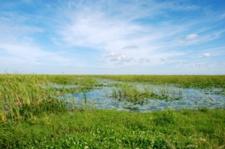
Interior Secretary Outlines How to Use North American Continent to Combat Climate Change
The U.S. Department of Interior plots a new use for public lands by using them as carbon sinks to abate global warming
Dec 11, 2009 - David Biello - Scientific American
 |
CARBON SINK: Interior Secretary Ken Salazar spoke at the United Nations' climate summit this week in Copenhagen about using U.S. lands, such as the Everglades, to mitigate climate change.
iStockphoto |
COPENHAGEN—U.S. forests and soils store some 90 billion metric tons of carbon, or 50 years worth of present U.S. emissions from fossil fuels, according to a new study from the U.S. Geological Survey. As negotiators here at the United Nations' climate summit continue to struggle to draft a global agreement to cut greenhouse gas emissions—including efforts to reduce deforestation and protect natural sinks—the U.S. Department of Interior is transforming the business of public lands and waters to help combat climate change.
First and foremost, on December 10, Secretary of the Interior Ken Salazar attempted to reassure the world that the U.S. is once again actively engaged in the global effort to combat climate change. "The U.S.A. understands the danger climate change poses to our world and we as a nation are committed to facing that challenge," he said at an event in the U.S. pavilion. "Climate change is affecting every corner of the American continent." For example, Florida's Pelican Island—the nation's first wildlife preserve formed in 1903— "is being consumed by the rising sea and may disappear."
Salazar outlined some of the mitigation efforts under way at Interior, which manages a full fifth of national lands as well as expanses of ocean off the coasts, including mineral and fossil fuel resources. The majority of those efforts in the 11 months of the Obama administration focus on turning the nation's public lands into resources for combating climate change—either as locations for renewable energy projects, carbon sinks or buffers against weird weather.
In addition to the 2,500 square kilometers that Interior is evaluating for solar power potential, the U.S. Department of Energy's National Renewable Energy Lab estimates that wind farms off the east coast could ultimately produce 1,000 gigawatts of power. "That's more power from wind alone than is needed to power the entire electrical needs of the U.S.," Salazar noted. He called for generating at least 20 percent of U.S. power from such wind resources by 2030—following in Denmark's footsteps—and noted that 5,300 megawatts of new renewable energy projects, including geothermal, refitted hydropower, solar and wind (on- and offshore), are currently being evaluated by his department for public lands, along with the transmission corridors to go with them.
The Interior Department is also focused on ensuring continued exploration of U.S. fossil-fuel resources, including Powder River Basin coal in Wyoming and new exploratory oil leases in the Chukchi Sea, among others. "We have to go through a transition. We have significant resources including oil and gas which will continue to be part of our energy portfolio for years to come," Salazar said. But "we are looking at geological formations in the U.S. such as oil and gas reservoirs and saline formations to determine how they can be used to reduce atmospheric levels of CO2. These are efforts to find the right places to store CO2."
Such carbon dioxide storage—along with the technology to capture it before it goes up the smokestack—will be critical as the U.S. and other countries, such as China and India, continue to burn coal to produce the majority of their electricity. "We have more coal in the U.S. perhaps than any other resource we have," Salazar noted. "The question is not whether we are going to continue to have coal as part of the energy portfolio. The real question is how can we reduce carbon emissions from coal."
Ultimately, Salazar also wanted to reassure the world that the U.S. will one day limit greenhouse gas emissions. "We will pass comprehensive carbon legislation in the U.S.," Salazar said at the event he called "an opportunity to tell the rest of the world what it is we are doing." He added: "We've already done a U-turn from the place where the previous administration was taking the country with respect to climate change and energy."
And a return of some of those public lands to fully functioning, as is being done with the ongoing restoration of the Everglades in Florida, could recreate new carbon sinks. "By restoring ecosystems, U.S. lands can store more carbon," Salazar said. "In the U.S., we are losing three million acres of land every year to development, an area the size of Connecticut. When we lose those areas for development we also lose carbon sinks that are created by vegetation in those places."

|



